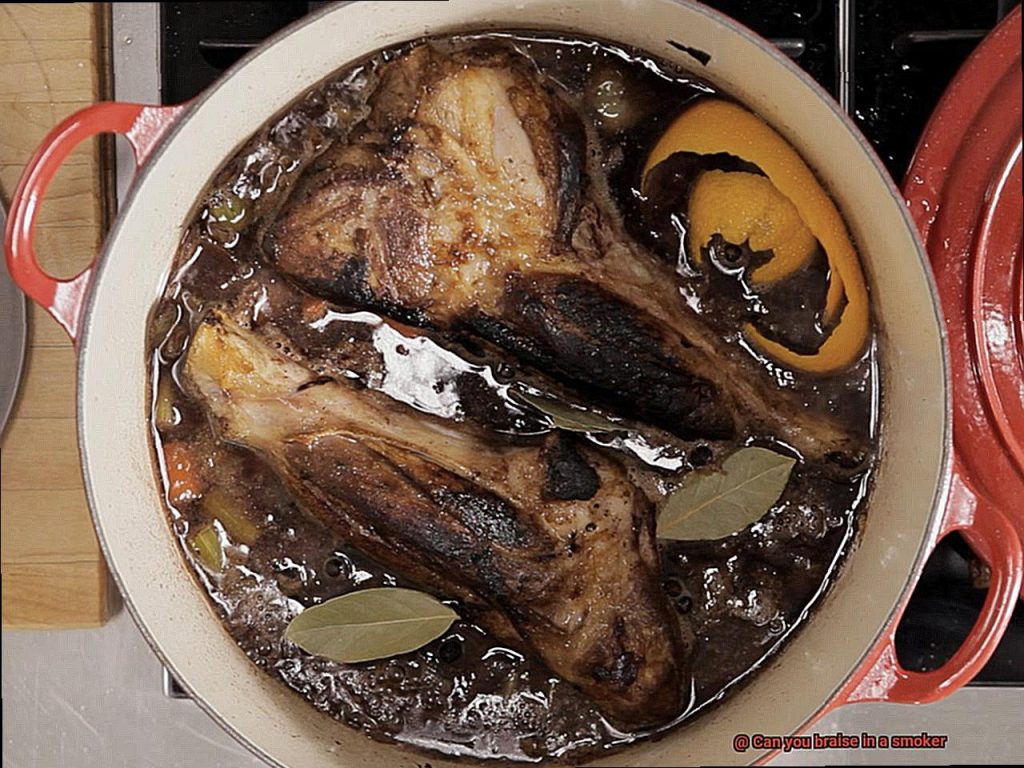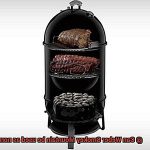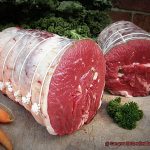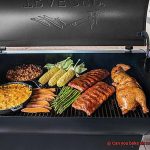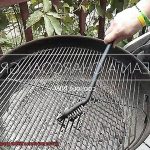Are you a self-proclaimed meat connoisseur who is always on the lookout for new ways to add some pizzazz to your dishes? Have you ever wondered if you can braise in a smoker? Braising, as a cooking technique, involves searing meat in a pan and then simmering it in liquid over low heat. This method is ideal for achieving tender, juicy, and flavorful meat. But can this mouth-watering cooking method be done in a smoker?
The answer is YES – you absolutely can braise in a smoker. With the right tools and techniques, you can create succulent and smoky braised meats that will make your taste buds dance with joy. Smoking meat is already a popular cooking technique that infuses rich, woodsy flavor into your food. When combined with braising, it packs an even stronger punch of savory goodness.
In this blog post, we’ll explore everything you need to know about braising in a smoker like a pro. We’ll show you how to select the perfect cuts of meat for smoking and braising, which types of wood chips to use for maximum flavor infusion, and how to adjust cooking times and temperatures for optimal results. Plus, we’ll share some delicious recipes to get you started on your journey towards becoming a master of braised smoked meats.
So buckle up and get ready to embark on an exciting culinary adventure. Get ready for an explosion of flavor in your mouth that will leave you wanting more.
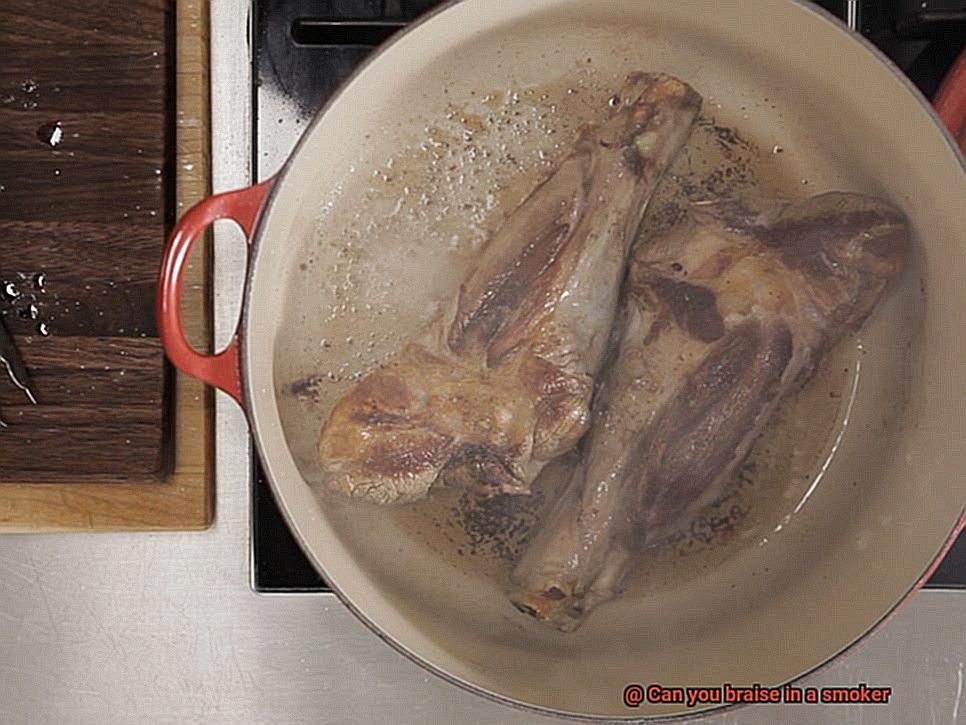
Contents
Can You Braise in a Smoker?
Braising in a smoker is a cooking technique that may seem unconventional, but it can add a depth of flavor to your favorite dishes that will leave your taste buds tingling. If you’re new to braising or smoking, don’t worry. With a little practice, you’ll be able to create tender, flavorful meats that are infused with smoky goodness.
Before you start, it’s important to select the right cut of meat. Tough cuts with lots of connective tissue work best because they benefit from the slow-cooking process that braising provides. Some popular options include beef brisket, pork shoulder, and lamb shanks.
Preparing your braising liquid is the next step. You can use anything from broth or stock to wine or beer, depending on your preference. Don’t forget to add plenty of aromatics like onions and garlic, as well as herbs and spices for extra flavor.
Now it’s time to smoke. Make sure your smoker can maintain a low and consistent temperature for several hours, usually around 300-325°F. Once your meat is seared, place it in the smoker and pour in the braising liquid until it reaches about halfway up the sides of the meat.
Cover the smoker tightly with foil or a lid and let it cook for several hours until the meat is fork-tender. The slow-cooking process will break down the connective tissue in the meat, making it incredibly tender and flavorful.
After cooking, let the meat rest for a few minutes before slicing or shredding. This allows the juices to redistribute throughout the meat, making it even more tender and juicy.
To summarize, here are some tips for braising in a smoker:
- Choose tough cuts of meat with lots of connective tissue.
- Prepare your braising liquid with plenty of flavor.
- Make sure your smoker can maintain a low and consistent temperature.
- Cover tightly and let it cook for several hours until the meat is tender and falling off the bone.
- Let the meat rest before serving.
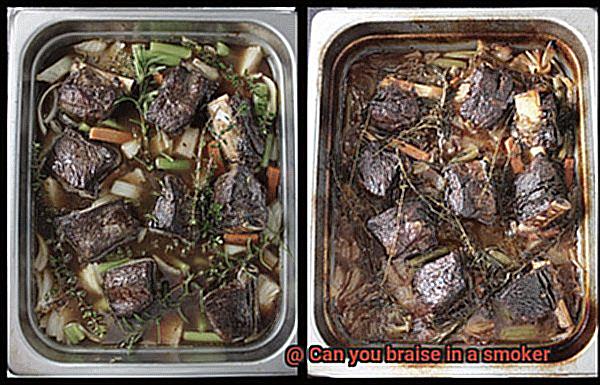
Choosing the Right Cut of Meat for Braising
Not all cuts are created equal and some may not hold up well during the smoking process. Therefore, let’s explore why selecting the right cut of meat is so crucial to creating a mouth-watering dish.
Firstly, you want to select a cut of meat with plenty of connective tissue. This might seem counterintuitive, but trust me on this one. Cuts like beef brisket, chuck roast, short ribs, pork shoulder, and lamb shanks are perfect for braising in a smoker because they contain a lot of connective tissue that breaks down during the braising process. This results in tender and flavorsome meat that falls off the bone.
On the other hand, opting for cuts with too little connective tissue can lead to a tough and unappetizing final product. Although cheaper cuts may be tempting, they often lack the necessary connective tissue to properly break down during braising. So, don’t be afraid to splurge on a higher quality cut of meat for optimal results.
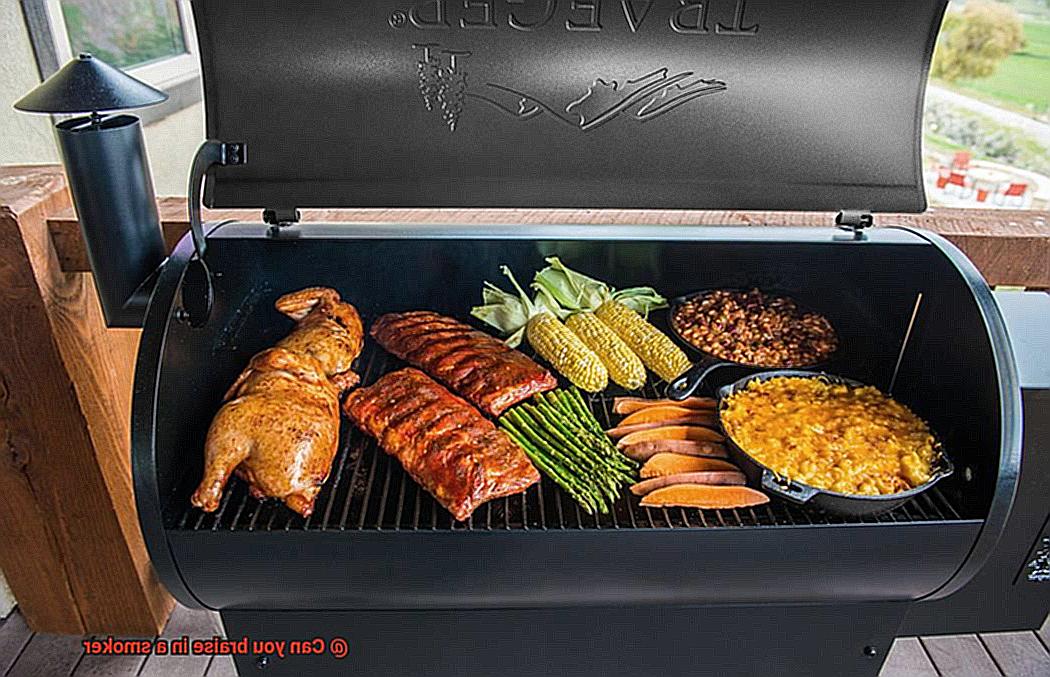
When smoking and braising your chosen cut of meat, it’s also important to properly trim any excess fat beforehand. While some fat is essential for flavor and moisture, too much can make your end result greasy and unpalatable. Opt for a balanced amount of fat to achieve delicious results.
Searing the Meat Before Placing it in the Smoker
Searing is a crucial step in creating mouth-watering braised meat that is both tender and flavorful.
To get started, you’ll need a hot grill or cast-iron skillet to sear your meat. Don’t forget to generously coat your meat with oil or butter to prevent sticking. Once your meat has formed a golden-brown crust on both sides, it’s ready to transfer to the smoker. But don’t forget, smoking requires indirect heat, so be sure to move your meat away from the direct heat source and allow it to cook slowly and evenly.
Now, let’s talk about the benefits of searing. When you sear your meat before smoking it, you’re locking in all those delicious juices and flavors. Plus, who doesn’t love a satisfying crunch when biting into a perfectly seared piece of meat?
But wait, there’s more. To keep your braised meat moist and flavorful, consider using a liquid such as broth or wine during the cooking process. You can place the liquid in a pan underneath the meat or pour it directly over the meat before covering with foil. This will create steam and help keep your meat tender during the smoking process.
Adding Liquid to the Pan for Braising
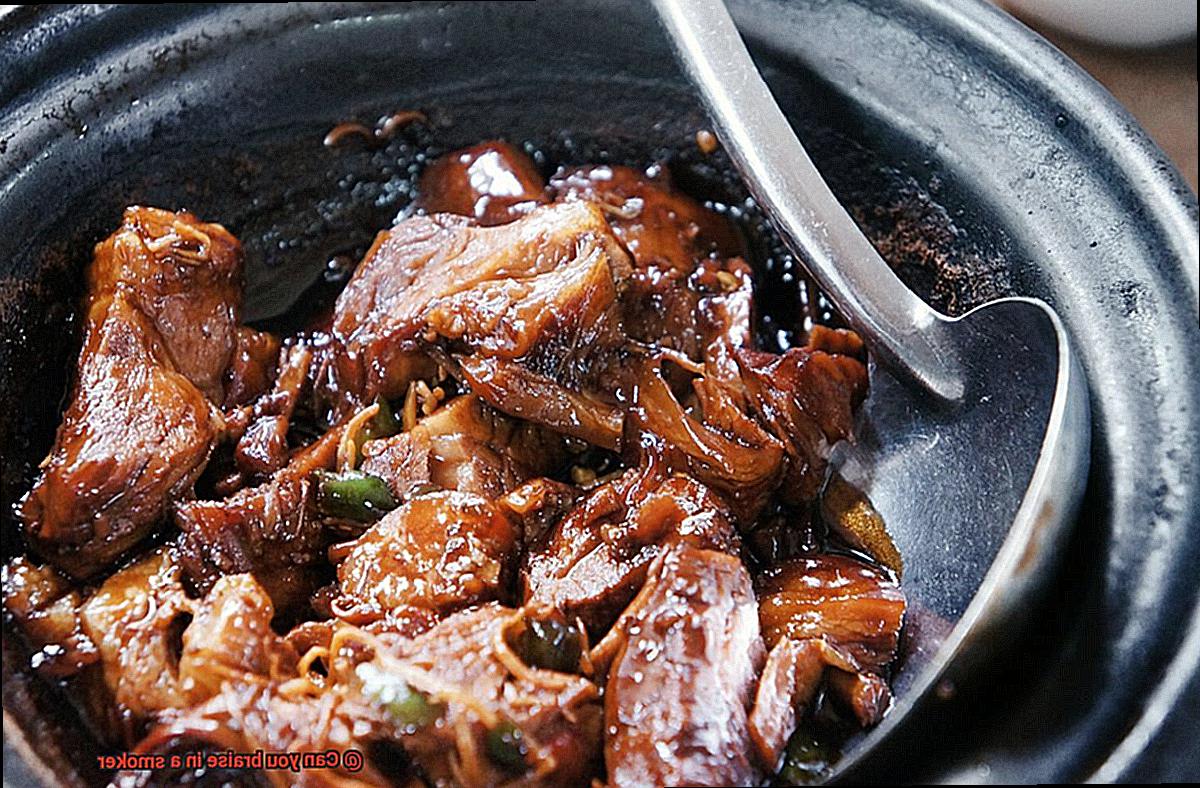
The liquid serves two important purposes: keeping the meat moist during cooking and infusing it with additional flavor. Say goodbye to dry, tough meat and hello to juicy, succulent bites. The type of liquid you choose is up to you, with options ranging from broth and stock to wine, beer, and even fruit juice.
Just remember not to completely cover the meat in liquid – braising involves cooking the meat partially submerged in liquid, so aim for one-third to one-half of the way up the sides of the meat.
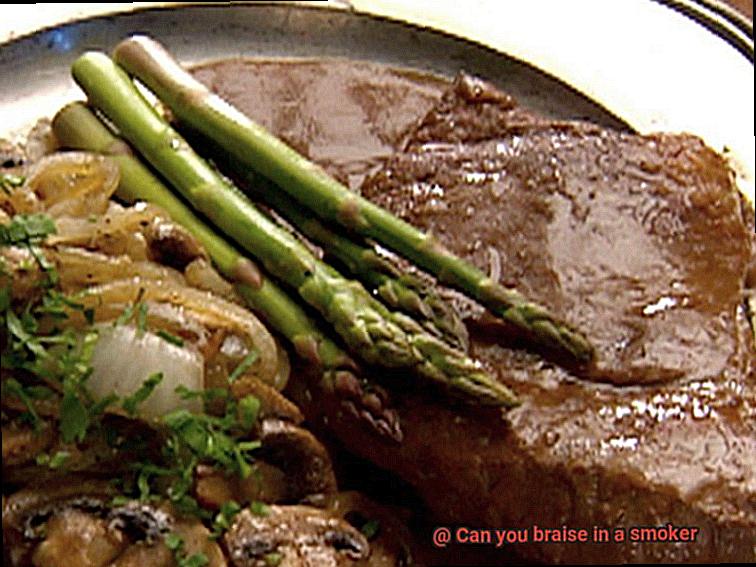
Before adding the liquid to the pan, take a moment to sear the meat. This not only helps to develop a crust on the outside of the meat but also locks in its juices for maximum flavor and tenderness.
Once seared, add your chosen liquid and keep an eye on it throughout cooking. If the liquid evaporates too quickly, add more as needed to prevent drying out. On the other hand, if there’s too much liquid left in the pan at the end of cooking, remove some and reduce it down into a delicious sauce or gravy.
In summary, adding liquid to the pan is crucial for successful braising in a smoker. It brings moisture and flavor to your meat while helping you achieve tender and delicious results. Remember these tips next time you’re smoking some meat and watch as your taste buds thank you.
Cooking the Meat at a Low Temperature
The answer lies in the technique of cooking meat at a low temperature. It is an essential technique in both smoking and braising and can result in juicy, flavorful meat.
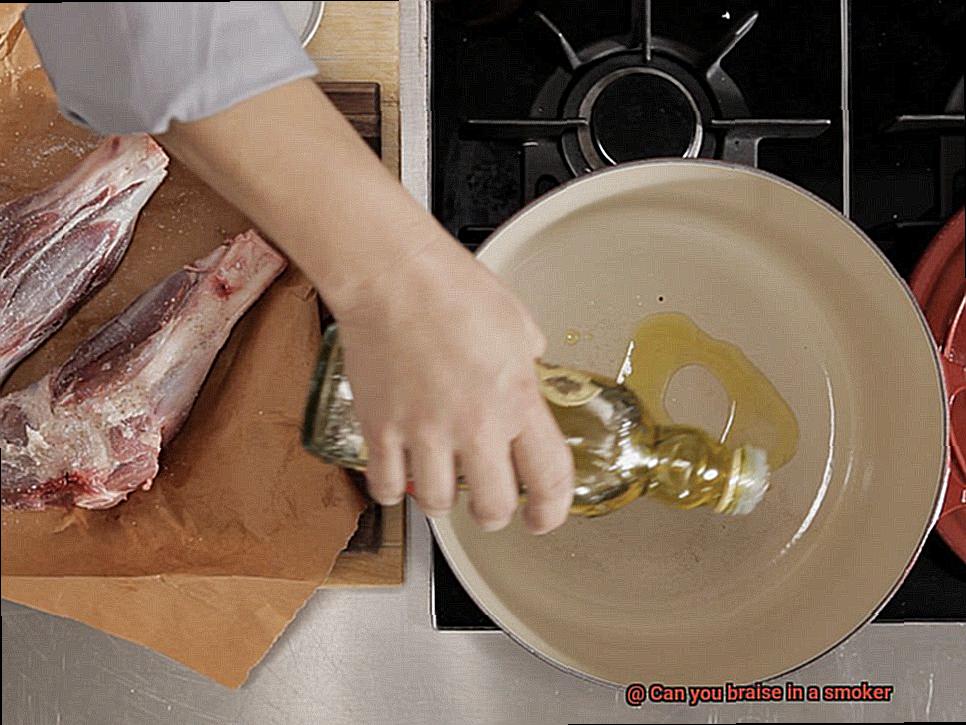
Braising involves searing the meat in a hot pan and then cooking it in a liquid at a low temperature for an extended period. This technique infuses the meat with the flavors of the cooking liquid, resulting in tender and juicy meat. Smoking, on the other hand, involves cooking the meat at low temperatures for several hours, allowing smoke to penetrate the meat and give it a unique smoky flavor.
If you’re looking to braise in a smoker, you need to ensure that your smoker can maintain a consistent low temperature and has enough room for your cooking vessel. A cast-iron Dutch oven or other heavy pot with a tight-fitting lid is perfect for braising in a smoker.
To start, sear your meat on all sides in a hot pan to create a flavorful crust and lock in the juices. Next, transfer the meat to your Dutch oven or other cooking vessel and add your braising liquid. You can use anything from beef or chicken broth to red wine or even beer.
Once your meat and liquid are ready, place the lid on your Dutch oven and transfer it to your smoker. Ensure that the smoker is set to the desired temperature and has enough wood chips or pellets to maintain a steady stream of smoke.
Now comes the waiting game. Cook the meat for several hours, checking it periodically to ensure that the liquid hasn’t evaporated and that the temperature remains consistent. You may need to add more liquid or adjust the heat as needed.
When the meat is done, remove it from the smoker and let it rest for a few minutes before serving. The result should be tender, juicy meat that is infused with delicious smoky flavors.
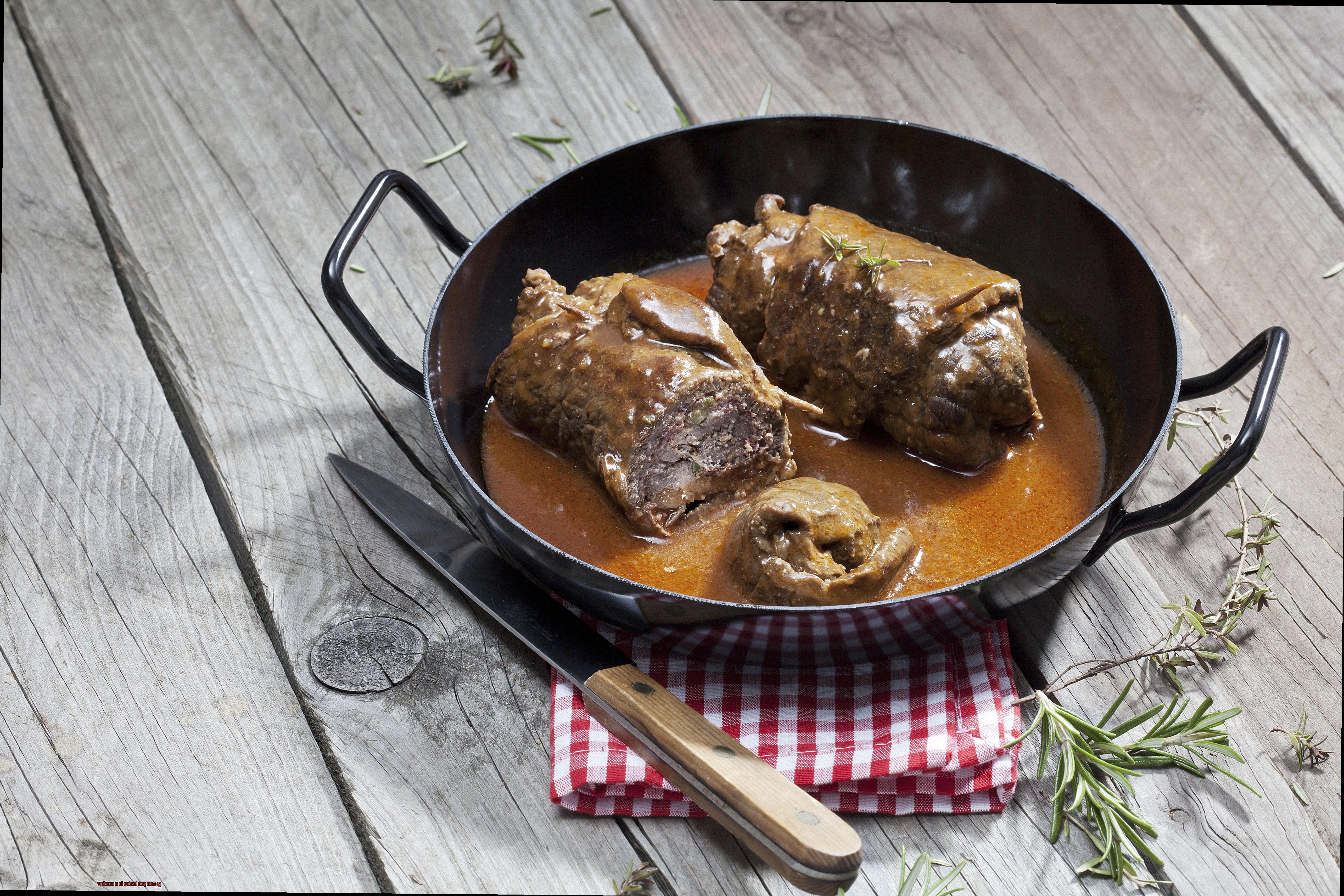
In summary, cooking meat at a low temperature is crucial for both smoking and braising. With the right equipment and technique, you can achieve mouthwatering results. Here are some tips to keep in mind:
Benefits of Using a Smoker to Braise
Look no further than your trusty smoker. As an expert in the world of smoking and braising, I can tell you that using a smoker to braise offers a whole host of benefits that will have you creating mouth-watering meals with ease.
First and foremost, the smoky flavor that a smoker adds to your dishes is unbeatable. The slow-cooking process of smoking allows for the flavors to develop and meld in a way that simply cannot be achieved through traditional braising methods. The result? A rich and complex taste that will tantalize your taste buds and leave you wanting more.
But the benefits don’t stop there. Using a smoker to braise also offers hands-off cooking, making it perfect for busy home cooks who still want to prepare a delicious meal. Once you’ve placed your ingredients in the smoker, there’s no need to constantly monitor or stir them, freeing up time for other tasks. This means you can enjoy more time with loved ones or simply relax after a long day.
Additionally, using a smoker to braise offers incredible versatility. While traditional braising often involves tougher cuts of meat, smoking can be used to braise vegetables or even seafood. This opens up a whole new world of possibilities for those who love experimenting with different flavors and ingredients. Imagine smoky, tender Brussels sprouts or succulent smoked salmon – the possibilities are endless.
Tips for Successful Braising in a Smoker
Braising in a smoker is a unique and delicious way to cook your favorite meats. However, it takes some skills and knowledge to ensure that your braising is successful and the end result is a perfectly cooked, juicy cut of meat. Here are the steps you need to take to braise successfully in your smoker:
Choose the right cut of meat
Braising is all about slow-cooking tough cuts of meat in liquid until they become tender. Therefore, it’s essential to select cuts like beef chuck, pork shoulder, or lamb shanks that have plenty of connective tissue and marbling. These cuts break down during the long cooking time and result in tender, flavorful meat.
Prep your meat and ingredients
Before you start braising, make sure to season your meat generously with salt and pepper. You can also add aromatics like onions, garlic, and herbs to enhance the flavor of your dish. Additionally, make sure to have enough liquid to cover at least half of the meat.
Use a sturdy pan
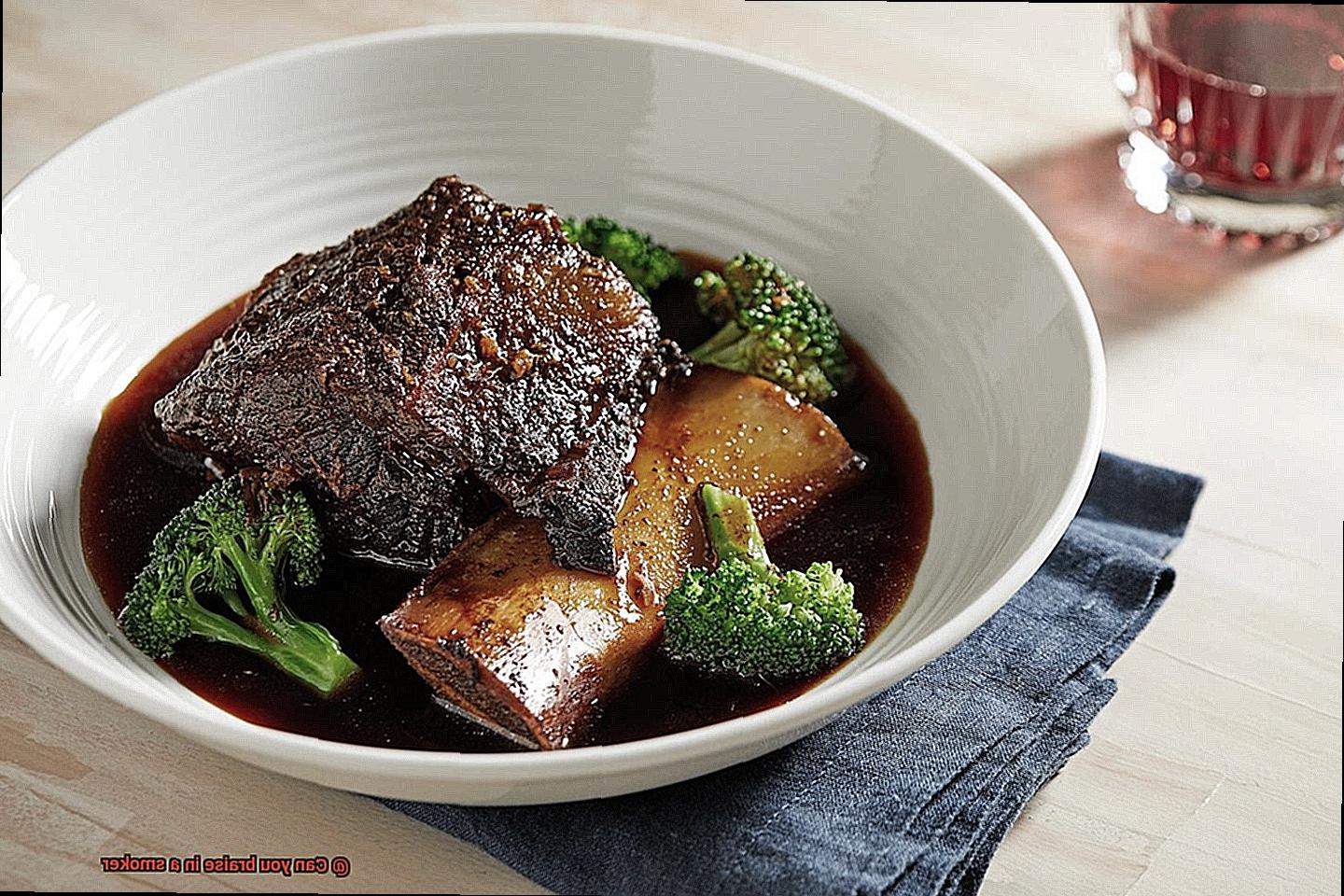
When braising in a smoker, it’s important to use a pan that can withstand high heat and won’t warp or buckle under pressure. Cast iron dutch ovens are an excellent choice as they retain heat well and distribute it evenly.
Keep an eye on the temperature
Temperature control is crucial when smoking and braising in a smoker. Smoking temperatures should be kept low (around 225-250°F), but when braising in a smoker, you’ll need to raise the temperature to around 300°F to ensure that the meat cooks through properly. Be sure to use a meat thermometer to check the internal temperature of the meat – it should reach at least 190°F for optimal tenderness.
Be patient
Braising takes time, usually several hours, so don’t be tempted to rush the process by increasing the temperature or removing the lid too often. This will disrupt the cooking process and prevent your meat from becoming tender. Allow the meat to rest for at least 15 minutes before slicing and serving.
Common Mistakes to Avoid When Braising in a Smoker
If you’re looking to elevate your braising game by using a smoker, be sure to avoid these common mistakes that can ruin your dish. As an expert in this field, I have seen these blunders made time and time again, so let me share some tips on what to avoid when braising in a smoker.
Firstly, don’t skimp on the liquid. Braising involves cooking food slowly in a liquid, and it’s crucial to use enough liquid to keep the meat moist and tender. When using a smoker, it’s easy to forget that the meat needs more liquid than when cooking on a stove or oven. The smoke and heat from the smoker can quickly evaporate any liquid that is added, so ensure that there’s enough liquid throughout the cooking process.
Secondly, choose the right cut of meat. Not all cuts are suitable for braising in a smoker. Tougher cuts such as beef brisket or pork shoulder are ideal because they have a lot of connective tissue that needs to be broken down to make the meat tender. Trying to braise leaner cuts of meat in a smoker can result in tough and chewy meat, so selecting the right cut is crucial.
Overcrowding the smoker is another common mistake when it comes to braising. When food is too close together, it can cause uneven cooking and prevent smoke from circulating properly around the meat. To avoid this mistake, ensure that there is enough space between the pieces of meat in the smoker and consider using multiple racks if necessary.
Lastly, monitoring the temperature closely is vital when smoking. Unlike other cooking methods, smoking requires more attention to temperature and time. Keeping a close eye on the temperature of the smoker and the internal temperature of the meat will ensure that it’s cooked correctly. If the temperature is too low, the meat will not cook evenly, and if it’s too high, it can dry out your dish.
oCuTI-kjJgQ” >
Conclusion
To sum it up, braising in a smoker is a game-changer when it comes to cooking meats. It elevates the flavor profile of your dishes and adds an irresistible smoky twist that will leave your guests raving. But as with any culinary technique, there are certain guidelines you need to follow to achieve optimal results.
Firstly, choose the right cut of meat – tougher cuts work best for braising as they can withstand the low and slow cooking process. Secondly, don’t skimp on flavor when preparing your braising liquid. Use herbs, spices, and aromatics to create a rich and complex taste. Thirdly, sear the meat before smoking it to lock in juices and add a crispy texture.
Once you’ve got these basics down, it’s time to get smoking. The benefits of using a smoker for braising are endless – from hands-off cooking that frees up your time to the unbeatable smoky flavor that infuses your meats.
However, there are some common mistakes you should avoid. Overcrowding the smoker or not monitoring the temperature closely can lead to unevenly cooked or dry meat. And choosing the wrong cut of meat can result in tough and chewy final product.
But fear not – by following our tips and avoiding these pitfalls, you’ll be able to create tender and juicy meats that will have everyone begging for seconds.

